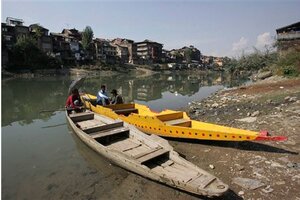Water supply of millions threatened by melting of Kashmir's glaciers
New study by scientists in India finds that the biggest glacier in the Indian portion of Kashmir has shrunk, imperiling the water supply of millions of people in the region..

Kashmiri boatmen wait for customers at the drying river Jehlum in Srinagar, India.
Mukhtar Khan/AP
SRINAGAR, India
Indian Kashmir's glaciers are melting fast because of rising temperatures, threatening the water supply of millions of people in the Himalayan region, a new study by Indian scientists says.
The study by Kashmir University's geology and geophysics department blamed the effect on climate change, and said it endangered the livelihoods of two-thirds of the region's nearly 10 million people engaged in agriculture, horticulture, livestock rearing and forestry.
The Kolahoi glacier, the biggest in the Indian portion of divided Kashmir, has shrunk to about 4.44 square miles (11.5 square kilometers) from about five square miles (13 square kilometers) in the past 40 years, the study found.
Shakil Romshoo, an associate professor in the department who led to three-year study, describes the rate of melting as "alarming." He says that Kolahoi had shrunk by 18 percent, and over the same period, other glaciers in the region had shrunk by 16 percent.
The Kolahoi feeds Kashmir's lifeline Jhelum River, which is also vital for agriculture in Pakistan's most populous province of Punjab.
The study was released recently at a workshop on the impact of shrinking glaciers held in Srinagar, the capital of Indian Kashmir.
Last year, international charity ActionAid also warned that the glaciers in most areas of Kashmir have shrunk. The group said that climate change was affecting rain and snowfall patterns, which was lowering food production.
Prof. Syeed Iqbal Hasnain, head glaciologist at New Delhi-based the Energy and Resources Institute, says the findings show again that "warming of the climate system was unequivocal."
Rajeev Upadhay, an Indian geologist who has studied glaciers since 1995, says the new study is in line with previous ones.
"The study confirms the general trend that about 90 percent of all Himalayan glaciers are receding. Some glaciers are receding at an alarming rate of 44-45 meters (yards) per year," says Mr. Upadhay, who was not involved in the Kashmir University study.
He also says the Siachen glacier, where rival Indian and Pakistani troops have been entrenched for 25 years, has melted to half its earlier size.
"The unusual climate change clubbed with other activities at the Siachen Glacier has reduced it to 46 miles (74 kilometers) from 93 miles (150 kilometers) in length," he says.
The Siachen Glacier is often dubbed the world's highest battlefield. The nuclear-armed South Asian nations have competing territorial claims to Siachen and troops have been locked in a standoff there at an altitude of up to 20,000 feet (6,100-meter) since 1984.
India and Pakistan have fought two wars over control of Kashmir since 1947 after they won independence from Britain. Both claim the divided territory in its entirety.
Editor’s note: See also "Indians decide to make their own glaciers."
For more articles about the environment, visit the Monitor’s main environment page, which offers information on many environment topics. Also, check out our Bright Green blog archive and our RSS feed.
